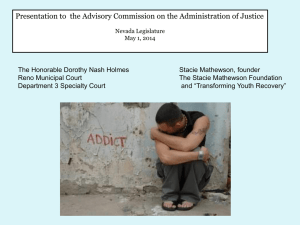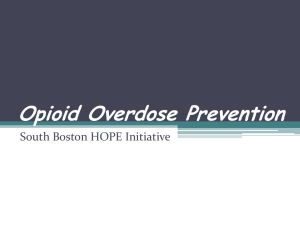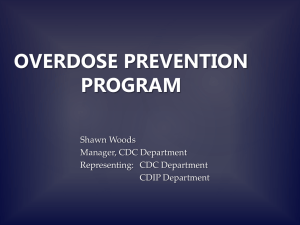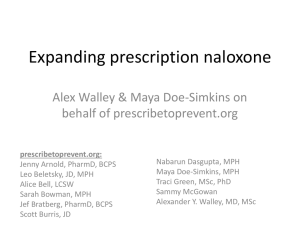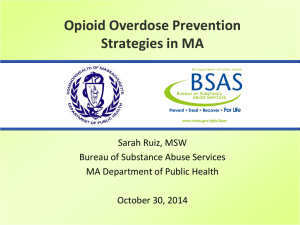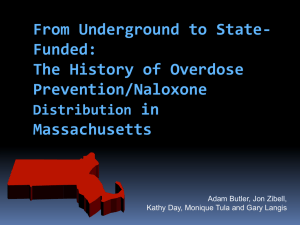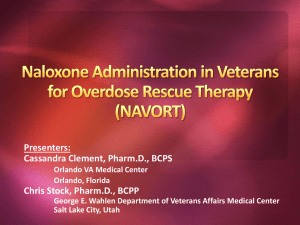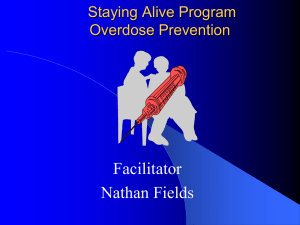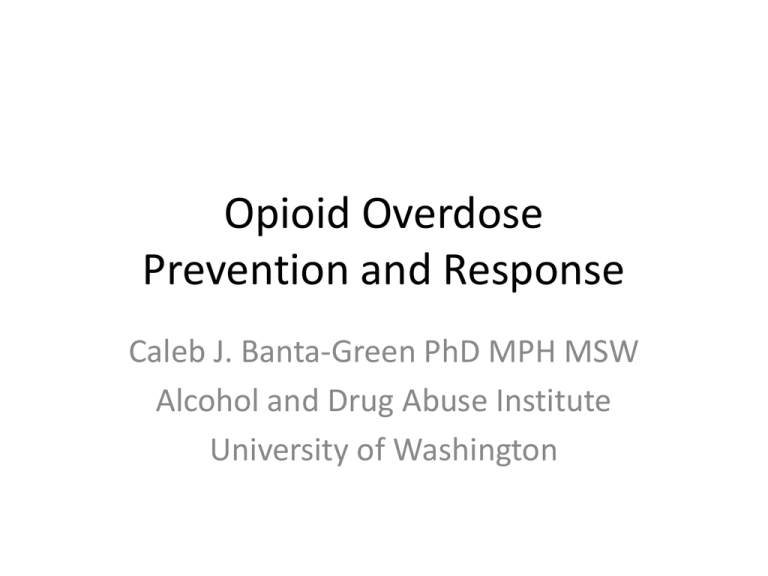
Opioid Overdose
Prevention and Response
Caleb J. Banta-Green PhD MPH MSW
Alcohol and Drug Abuse Institute
University of Washington
Outline
• Basic overdose training
–
–
–
–
Video
Presentation
Discussion/Q&A
Questionnaire- Quiz, Optional training evaluation
• Overdose education nationally and locally
– Epidemiology
– History of OD education
– Support for adding a medical model
• King County drug trends
• Heroin first time treatment admits in WA
Opioid, Opiate
• In this presentation they are used
interchangeably
• Yes, technically they are different
Video
1. Rub to wake.
• Rub your knuckles on the bony part
of the chest (sternum) to try to get
them to wake up and breathe.
2. Call 911.
All you need to say is:
• The address and where to find the person
• A person is not breathing
• When medics come, tell them what drugs the
person took if you know
• Tell them if you gave naloxone
3. If the person stops breathing, give
breaths mouth-to-mouth or use a
disposable breathing mask.
• Put them on their back.
• Pull the chin forward to keep the airway open;
put one hand on the chin, tilt the head back,
and pinch the nose closed.
• Make a seal over their mouth with yours and
breathe in two breaths. The chest, not the
stomach, should rise.
• Give one breath every 5 seconds.
4. Give naloxone.
• For injectable naloxone: Inject into the arm or
upper outer top of thigh muscle, 1 cc at a time.
Always start from a new vial.
• For intranasal naloxone: Squirt half the vial into
each nostril, pushing the applicator fast to make a
fine mist.
• Discard any opened vials of naloxone within 6
hours
5. Stay with the person and keep them
breathing.
• Continue giving mouth-to-mouth breathing if
the person is not breathing on their own.
• Give a second dose of naloxone after 2-5
minutes if they do not wake up and breathe
more than about 10-12 breaths a minute.
• Naloxone can spoil their high and they may
want to use again. Remind them naloxone
wears off soon and they could overdose again.
6. Place the person on their side.
• People can breathe in their own vomit and
die. If the person is breathing, put them on
their side. Pull the chin forward so they can
breathe more easily. Some people may vomit
once they get Naloxone; this position will help
protect them from inhaling that vomit.
7. Convince the person to follow the
paramedics' advice.
• If the paramedics advise them to go to the
Emergency Room, health care staff will help:
• Relieve symptoms of withdrawal
• Prevent them from overdosing again today
• By having an observer who can give more
naloxone when the first dose wears off
• Assess and treat the person for other drug
overdoses. Naloxone only helps for opioids.
8. What if police show up?
• The Washington State 911 Good Samaritan
Drug Overdose Law (RCW 69.50.315) lets
bystanders give naloxone if they suspect an
overdose.
• The law protects the victim and the helpers
from prosecution for drug possession. The
police can confiscate drugs and prosecute
persons who have outstanding warrants from
other crimes.
Questions?
Evaluation
• Anonymous and voluntary
• See the information statement
• If you are willing1. Take the quiz/evaluation, place in envelope
when done
2. Write down email for follow up survey on
separate page
Opiate Overdoses in the U.S.
Epidemiology, Prevention,
Intervention and Policy
Heroin substantially under-reported in deaths
Rx Opioids- Pain Medications
• Prescribing appears to be leveling off for
potent, long acting opioids in some states
(ARCOS 2010)
• Mortality increasing nationally, declining in WA
• NSDUH says non-medical opioid “pain reliever”
opioid use declined in 2011
Washington State Reducing Opioid
Related Deaths
18
Heroin
• More people report using heroin in the last
year - 620,000 in 2011 from 373,000 in 2007.
NSDUH
• 15 of 21 US cities report increases in heroin,
notably among young adults and non-urban
areas (NIDA Community Epidemiology Working Group June 2012)
• 18-24 year olds admitted for heroin tx up:
42,637 in 2000 to
67,059 in 2009 TEDS cited in [A]
A. Banta-Green, CJ 2012 Adolescent Abuse of Pharmaceutical Opioids Raises
Questions About Prescribing and Prevention. Arch Pediatr Adolesc Med. 2012
May 7. [Epub ahead of print]
Rx to Heroin
• Misuse of prescription opioids is related to
subsequent heroin use is indicated by NSDUH
data* and published research** particularly
adolescents and young adults
• King County, 39% of needle exchange visitors
reported being “hooked on rx-type opioids”
before they began using heroin (2009)
*C. Jones 2013 article
** Peavy et al, 2012 and Lankenau et al, 2012
Background Opioid Overdoses
• Overdose deaths can be prevented
• Bystanders can intervene in heroin and/or
prescription drug overdoses and prevent death
• Poor knowledge about overdoses by those at risk
• Risk factors; signs of overdose; how to intervene
• Target audiences includes other users, family,
friends, police, etc
• Fear of police may inhibit calling 911
• Perceptions are powerful
• An antidote is available
• Supply and access points are limited
Fatal opioid
overdose rate is
high
Logic Model
Educate public
• O.D. knowledge low
• Antidote hard to get
• Fear of police/law
Change
law,
Pharmacy
practice
&/or
medical practice
Behaviors and
practices change
Increase
naloxone supply
and access
Fatal opioid
overdose rate is
low
O.D. Knowledge
How to increase
• General awareness needed that
opioid overdoses can be prevented
and if they occur they can be
reversed with naloxone
– National problem, need broad
awareness
– Supply and demand need to be built
• Regular user of opioids could receive
overdose education and take-home
naloxone
• Family/friends of regular high risk
users should receive overdose
education and obtain naloxone
• SAMHSA OD Toolkit
Antidote/Naloxone
Increasing access
• Clinicians can prescribe to persons at risk of
overdose [recommended in SAMHSA OD Toolkit]
• Potential settings- clinic, Emergency Dept, pharmacy, drug
treatment, jail
• Insurance (public and private) could cover Rx costs
• Pharmacists could directly prescribe and dispense
• Collaborative practice agreement
• lowers cost and increases access for underserved populations
• Overdose education and prescribing time could be
reimbursed
• SBIRT codes should allow reimbursement for education
• Pharmacists’ time educating could be reimbursed
Antidote/Naloxone
Increasing access
Maintain, support and expand community,
syringe exchange, social service agency based
education and delivery models
Source: the Network for Public Health Law
OD Education & Naloxone distribution
• Historically focused on heroin users
• Recently addressed prescription drug overdose
e.g. Project Lazarus
• Key OD educational elements:
– Prevention, Recognition, Intervention, Follow up
– In person, some with video, online in development
• NYC Dept. of Health-for non-medical users http://vimeo.com/4495088
• Project Lazarus - for pain patients
http://www.projectlazarus.org/patients-families/videos
Naloxone access
• Q. Who can be prescribed naloxone?
• A. A prescriber can prescribe take-home naloxone to
anyone who is at risk for opioid overdose.
– WA state explicitly allows for the prescription of take-home
naloxone to persons at risk for witnessing an overdose.
• Q. Where can naloxone be obtained?
• A. Naloxone availability varies by city/town. Generally
very limited.
– To locate overdose education & prevention and naloxone
programs http://hopeandrecovery.org/locations/
– Current efforts to get in community based pharmacies
Q. What has research shown to be the
impacts of distributing Naloxone to
potential overdose bystanders?
• Naloxone administration has not resulted in dangerous
health outcomes;(b)
• Drug users are willing to administer naloxone to each
other;(c)
• Naloxone availability does not increase drug use;(d)
• Those who receive overdose education and take-home
naloxone may decrease their own risk for overdose by
reducing drug use and/or entering drug treatment;(e,f)
Cont.
• More than 10,000 opioid overdoses have been
reversed with naloxone given by bystanders in
the U.S.
– Naloxone distribution programs generally provide
overdose prevention training and take-home
naloxone.
– More than 100 programs that distribute naloxone to
opioid users are operating in at least 15 states. (g)
• As of 2012, two US studies in the United States
underway to evaluate education and naloxone
distribution to populations at high risk for
overdose.(h)
Reduction in population death rate when 150/100,000 population were trained
Opioid overdose prevention with intranasal
naloxone among people who take methadone.
Walley AY, Doe-Simkins M, Quinn E, Pierce C, Xuan Z, Ozonoff A.
J Subst Abuse Treat. 2013 Feb;44(2):241-7. doi: 10.1016/j.jsat.2012.07.004. Epub 2012 Sep 12.
Boston University School of Medicine, Clinical Addiction Research Education Unit, Section of General Internal Medicine, Boston, MA 02118, USA.
awalley@bu.edu
Overdose education and naloxone distribution (OEND) is an intervention that
addresses overdose, but has not been studied among people who take
methadone, a drug involved in increasing numbers of overdoses. This study
describes the implementation of OEND among people taking methadone in the
previous 30 days in various settings in Massachusetts. From 2008 to 2010, 1553
participants received OEND who had taken methadone in the past 30 days.
Settings included inpatient detoxification (47%), HIV prevention programs
(25%), methadone maintenance treatment programs (MMTP) (17%), and other
settings (11%). Previous overdose, recent inpatient detoxification and
incarceration, and polysubstance use were overdose risks factors common
among all groups. Participants reported 92 overdose rescues. OEND programs
are public health interventions that address overdose risk among people who
take methadone and their social networks. OEND programs can be
implemented in MMTPs, detoxification programs, and HIV prevention
programs.
Evidence base
• We know naloxone works physiologically
– Used by EMS and in hospitials for decades
• Community based OD education and takehome naloxone shown to impact death rates
at population level
• Evaluations of existing programs not had $ for
rigorous research…
Fear of police/law
How to minimize
• State Good Samaritan overdose laws can change practice + perception
• City/County Prosecutorial/Police policy can be changed or made explicit
• Police can be trained and allowed to administer naloxone e.g. Quincy
Mass
• I , believe we have spread the word that no one should fear calling the
police for assistance and that the option of life is just a 911 call away.
We have also reinforced with the community that the monster is not in the
cruiser but indeed the officer represents a chance at life. Lt. Glynn
• Public Health/Law Enforcement communication and coordination
– To discuss overdose as public safety issue
• Training police and public essential
– Transparency builds trust
Drug Use Trends 2012
King County & WA State
Caleb Banta-Green PhD MPH MSW
Alcohol & Drug Abuse Institute
University of Washington
April 16, 2013
Data sources
•
•
•
•
•
Police evidence- tested by WSP crime lab
Healthy Youth Survey data- High School
Helpline calls
Treatment data from publicly funded facilities
Drug associated overdose deaths
WA State, 12th Graders, 2012 Healthy Youth Survey
Use
Estimate
Alcohol, past month
36.1%
Marijuana, past month 26.7%
Rx opiates, past month
7.5%
95%
C.I.
± 2.3%
± 1.5%
± 1.0%
Heroin, ever used
± 1.3%
5.1%
Association
?
Lifetime Heroin Use
No
Yes
Total
23% of recent users of Rx opiates to "get high"
report ever using heroin, compared to 3% for
those not recent using pain killers to get high
Current no days
Use of Rx
Opiates
"to get
high" any days
96.6%
3.4%
100.0%
± 0.9%
2,703
± 0.9%
94
2,797
77.2%
22.8%
100.0%
± 5.8%
193
± 5.8%
57
250
"Mother calling about son with SUD. Reports
that she's experienced with SUD and he's been
using heroin for about 1 year and is now
injecting. ….In the past year, the son has lost 2
heroin-addicted friends to suicide with guns to
the head because they couldn't get treatment
and were afraid of detoxing.“ RURAL WA
•
•
•
•
•
•
•
•
Publicly funded admissions to Inpatient, Outpatient and methadone maintenance
Treatment admits strongly influenced by funding, capacity, and demand
Capacity expanded in mid-2000’s
Cocaine treatment down everywhere
Heroin admissions increased substantially in King County in 2012, and dramatically
statewide
Methamphetamine decreased more across state than in King County
Marijuana slight declines
Prescription pain pills (oxycodone, etc) down a bit in 2012 from peak
• As every other substance declined,
– heroin increased 224% in King
– 512% Statewide among 18-29 year olds
Heroin route of ingestion among FIRST
time admissions
• These are incident cases of people entering
treatment for heroin for the first time (unique
people)
• First year of data is 2003, to account for
possible duplication issues in this dataset.
Note that smoking heroin is very hard on the lungs
and many may switch to injection quickly
N=5,649 total
Southeast- NorthNortheast- Yakima Tri- Snohomish
Spokane
Cities
Whatcom
2012 Rate
per 100,000
% change
2003-2012
King
Pierce
Kitsap
WestClark
Clallam
STATE
7.5
9.7
18.0
10.5
10.6
13.6
11.8
75%
177%
228%
35%
33%
164%
92%
•
•
All of these deaths were preventable
Many of these overdoses could have been reversed before they became fatal
Conclusions
• Nationally young adult heroin treatment admits are
up 57%
• Treatment data indicate a dramatic increase in heroin
use among young adults 18-29 across Washington
State.
– These data are a substantial, but unknown,
understatement of heroin treatment utilization
(and need) given the exclusion of private/self pay
treatment including buprenorphine maintenance
treatment
• These findings raise questions about the ability of
local communities to meet the treatment needs of
new heroin users, let alone the public health needs
including overdose and infectious disease risks.

